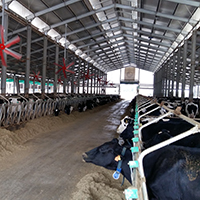Assessing the effect of barns structures and environmental conditions in dairy cattle farms monitored in Northern Italy

Published: 23 December 2021
Abstract Views: 1229
PDF: 587
HTML: 14
HTML: 14
Publisher's note
All claims expressed in this article are solely those of the authors and do not necessarily represent those of their affiliated organizations, or those of the publisher, the editors and the reviewers. Any product that may be evaluated in this article or claim that may be made by its manufacturer is not guaranteed or endorsed by the publisher.
All claims expressed in this article are solely those of the authors and do not necessarily represent those of their affiliated organizations, or those of the publisher, the editors and the reviewers. Any product that may be evaluated in this article or claim that may be made by its manufacturer is not guaranteed or endorsed by the publisher.
Similar Articles
- Najmun Nahar, Alex Otieno Owino, Zakaria Hossain, Influence of the initial setting of cement on the shear strength of rice husk ash stabilised soil , Journal of Agricultural Engineering: Vol. 53 No. 4 (2022)
- Giuseppe Modica, Francesco Solano, Angelo Merlino, Salvatore Di Fazio, Francesco Barreca, Luigi Laudari, Carmelo Riccardo Fichera, Using Landsat 8 imagery in detecting cork oak (Quercus suber L.) woodlands: a case study in Calabria (Italy) , Journal of Agricultural Engineering: Vol. 47 No. 4 (2016)
- Vidas Damanauskas, Algirdas Janulevičius, Effect of tillage implement (spring tine cultivator, disc harrow), soil texture, forward speed, and tillage depth on fuel consumption and tillage quality , Journal of Agricultural Engineering: Vol. 53 No. 3 (2022)
- Alessandro Parenti, Piernicola Masella, Lorenzo Guerrini, Antonio Guiso, Paolo Spugnoli, Energetic and economic viability of olive stone recovery as a renewable energy source: a Southern Italy case study , Journal of Agricultural Engineering: Vol. 45 No. 2 (2014)
- Alessandro Benelli, Chiara Cevoli, Angelo Fabbri, Luigi Ragni, Hyperspectral imaging to measure apricot attributes during storage , Journal of Agricultural Engineering: Vol. 53 No. 2 (2022)
- Melis Inalpulat, Monitoring and multi-scenario simulation of agricultural land changes using Landsat imageries and future land use simulation model on coastal of Alanya , Journal of Agricultural Engineering: Vol. 55 No. 1 (2024)
- Dario Friso, Lucia Bortolini, Influence of the trajectory angle and nozzle height from the ground on water distribution radial curve of a sprinkler , Journal of Agricultural Engineering: Vol. 43 No. 1 (2012)
- Pier Riccardo Porceddu, Valentina Babucci, ANALYSIS OF THE MAIN RISK FACTORS FOR WORKERS’ SAFETY IN SOME DAIRIES , Journal of Agricultural Engineering: Vol. 38 No. 3 (2007)
- Xin Yu, Ling Zhao, Zongbin Liu, Yiqing Zhang, Distinguishing tea stalks of Wuyuan green tea using hyperspectral imaging analysis and convolutional neural network , Journal of Agricultural Engineering: Vol. 55 No. 2 (2024)
- Antonio Guiso, Alessandro Parenti, Piernicola Masella, Lorenzo Guerrini, Fabio Baldi, Paolo Spugnoli, Environmental impact assessment of three packages for high-quality extra-virgin olive oil , Journal of Agricultural Engineering: Vol. 47 No. 4 (2016)
<< < 17 18 19 20 21 22 23 24 25 26 > >>
You may also start an advanced similarity search for this article.

 https://doi.org/10.4081/jae.2021.1229
https://doi.org/10.4081/jae.2021.1229







